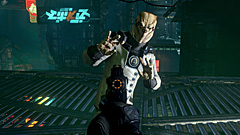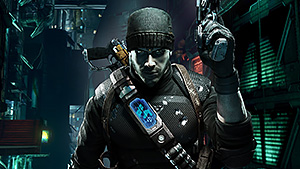May 12, 2017 by Paul Curtin

After just successfully launching the sequel for Dishonored back in November, Arkane Studios is back already with the spiritual sequel to System Shock. Although now going by the name Prey, Arkane’s latest is anything but a successor to 2006’s Prey and completely unrelated to the highly-anticipated Prey 2 project that was cancelled years ago.
Like Dishonored 2, Arkane’s take on Prey offers gamers the option of playing as a male or female version of new lead protagonist Morgan Yu. It’s a somewhat superficial choice that doesn’t have a real impact on the storyline… but also a choice that gamers will appreciate for providing slightly different variations of dialog, photos, and video recordings.
As teased in the trailers, the story begins with Morgan waking up in his luxurious high-rise apartment to another sunny San Francisco day in the year 2032. Shortly after a sleek opening credits sequence and a clever “physical and psychological test” tutorial, hostile shape-shifting aliens referred to as the Typhon show up, and Morgan’s world begins to spiral out of control.

It’s during these first twenty minutes of Groundhog Day/Edge of Tomorrow-inspired twists and turns that Prey is at its best. Nothing and no one can be trusted, and first encounters with the Typhon are unlike any sci-fi or horror game to date.
The smaller Typhon, referred to as mimics, are the game’s standout feature. The facehugger-like spider monsters are capable of transforming themselves into copies of ordinary objects. Since mimics can hide at any time within any environment and jump out at you when you least expect, you’ll constantly be second-guessing every item you come across. Prey‘s loot system is an exercise in reprogramming yourself to fight the urge to rush into rooms picking up every item you see — especially after previous games have conditioned you that it’s safe to grab everything that isn’t bolted down.
This unique enemy mechanic pairs perfectly with Prey’s spectacular inventory and crafting systems. Almost every item you come across can be stored in Morgan’s inventory and then taken to a recycling station to be broken down into raw materials. After the recycler spits out new materials like an addicting slot machine, you can then take those parts to fabricators and subsequently 3D print guns, ammo, and other items that come in limited supply.
To add to the game’s early suspense, Morgan is first only equipped with a wrench to take out the Typhon. Prey’s second-best feature comes shortly after the intro in the form of a GLOO Cannon (Gelifoam Lattice Organism Obstructor), which can hurl giant blobs that freeze objects on contact. In most cases, the wrench and cannon make for an exciting and hectic one-two combo of freezing foes and then rushing over to shatter them before the GLOO effect wears off.

But using the GLOO Cannon’s freezing effect on enemies serves only half of its purpose, and it can also cleverly be used to plug holes in broken pipes, put out fires, and create stepping stones up the sides of walls. This comes in handy when you can’t simply open a door because you don’t have the code, haven’t upgraded the hacking skill high enough, or just can’t stand the game’s frustrating hacking system. I found myself using GLOO mostly to conserve ammo and as a quick means to access otherwise unreachable areas within the game’s beautifully-crafted Metroidvania level design.
While enough good things can’t be said about Prey’s foundation of concepts that Arkane has successfully implemented, the gameplay unfortunately doesn’t change much after the first couple hours. New enemies with different strengths and weaknesses show up, but none of which outshine first contact with the mimics.
Weapons like the shotgun and silenced pistol can be improved with basic upgrades, such as increased power and range and faster reload speeds… but other than a Recycler Grenade (think a mini black hole that spits back out items that can be used for crafting), Prey’s arsenal of weapons never surpasses what’s introduced in its opening act.
With most of the weapons being on the bland side, Prey diversifies gameplay by focusing more on a plasmid-like upgrade system of “neuromods” that can be injected into Morgan’s eye and used to unlock new power-ups. Like BioShock and Dishonored, these upgrades allow you to customize Morgan based on your own personal playstyle. The first set of these skill trees allows for rather basic upgrades, such as increased health/effectiveness of medkits, access to hacking higher level systems, repairing turrets, and increased slots for weapon upgrades — none of which are too thrilling.

Since the Typhon are the game’s most interesting aspect, thankfully there are also three additional alien-based skill trees that grant Morgan access to the same powers that alien foes use against him in combat. Without giving too much away, the most interesting of said alien powers is the ability to mimic matter and transform into objects simply by targeting them. This works well when you need to squeeze by a narrow passage that Morgan himself is too big to fit through, but it doesn’t play out as well when trying to mess with the Typhon — whose A.I. isn’t as advanced as the humans in the Dishonored series.
Although not as memorable as a trip to Rapture in BioShock or as creative as the more linear levels of the Dishonored series, Arkane’s art-deco take on a minimalist/futuristic level design is still top-notch. Almost every new room you enter tells its own story, helping Talos 1 feel like a believable space station during an alternate timeline in which JFK wasn’t assassinated. New items, upgrades, characters, enemies, emails, audio logs, and side-missions don’t do much to stand out by themselves, but together help bring the atmosphere to life and keep the intriguing story moving along at a steady and rewarding pace.
After all the technical problems reported with Dishonored 2, many PC owners were skeptical about the developers’ controversial decision not to release a free demo of Prey on PC, while offering it on PlayStation 4 and Xbox One. However, just like our early impressions of Prey and experience reviewing Dishonored 2, we had almost no issues playing Prey on an i7 rig with a powerful GTX 980 Ti video card… that being said, there have been numerous performance issues reported by other players on PC, which Arkane is working on fixing.
The Verdict
Overall, Arkane’s version of Prey is an enjoyable experience filled with a few new concepts that are sure to be mimicked by other games in the future. However, the story falls just short of surpassing the games that it heavily takes inspiration from. While the story loses some of its steam midway through, the 16+ hour campaign finishes strong with multiple different endings and one shocking final twist after the credits that teases Arkane’s own Prey 2.
Though not quite enough to make us completely forget about what could have been with Human Head’s Prey 2, Arkane’s latest is without question one of the better space sims to be launched recently and a must-play for fans of the sci-fi genre. Prey gets 4 out of 5 stars (Great).
The Pros
- Mimic encounters are unlike anything we’ve played before
- GLOO Cannon’s ability to serve multiple functions
- Spectacular inventory and crafting systems
- Beautifully-crafted Metroidvania level design
- Typhon upgrades allow you to mimic the mimics and play your way
- Multiple endings based on the choices you make
The Cons
- Story starts off way better than it ends
- Enemy A.I. doesn’t feel as challenging as previous Arkane games
- Mostly bland weapons make gunplay repetitive
- Supporting characters don’t make a lasting impression














